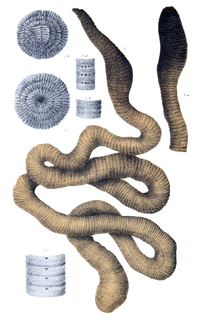
Moles are small mammals adapted to a subterranean lifestyle. They have cylindrical bodies, velvety fur, very small, inconspicuous ears and eyes, reduced hindlimbs, and short, powerful forelimbs with large paws adapted for digging.

Lumbricus terrestris is a large, reddish worm species widely distributed around the world. In some areas where it is an introduced species, some people consider it a serious pest for outcompeting native worms. It has an unusual habit of copulating on the surface at night, which makes it more visible than most other earthworms.

Lumbricus contains some of the most commonly seen earthworms in Europe. The genus has nearly 700 valid species.

Oligochaeta is a subclass of animals in the phylum Annelida, which is made up of many types of aquatic and terrestrial worms, including all of the various earthworms. Specifically, oligochaetes comprise the terrestrial megadrile earthworms, and freshwater or semiterrestrial microdrile forms, including the tubificids, pot worms and ice worms (Enchytraeidae), blackworms (Lumbriculidae) and several interstitial marine worms.

The Megascolecidae are a large family of earthworms which has native representatives in Australia, New Zealand, both Southeast and East Asia, and North America. The most ancient lineages of the family show a Gondwanan distribution and have been used as evidence of continental drift. Members of the Pheretima group of genera are widely distributed around the tropics, much as some Lumbricidae are distributed through the temperate zones. Some North American native genera – e.g., Arctiostrotus, Argilophilus and Driloleirus – also belong to this family.

James and the Giant Peach is a popular children's novel written in 1961 by British author Roald Dahl. The original first edition published by Alfred Knopf featured illustrations by Nancy Ekholm Burkert. There have been reillustrated versions of it over the years, done by Michael Simeon for the first British edition, Emma Chichester Clark, Lane Smith and Quentin Blake. It was adapted into a film of the same name in 1996.

The giant Gippsland earthworm, Megascolides australis, is one of Australia's 1,000 native earthworm species. It is also commonly known as karmai, taken from the Bunwurrung language.

The Kinabalu giant red leech is a large bright orange-red coloured leech that is endemic to Mount Kinabalu, Borneo. It can grow to a length of over 50 cm (20 in).

Earthworm Jim is an American animated television series based on the video game with the same name, which appeared on Kids' WB for two seasons from September 9, 1995, to December 13, 1996. The series follows the adventures of an earthworm named Jim who is turned into a superhero by a robotic super suit. The video game and show were created by Doug TenNapel.

The giant Palouse earthworm or Washington giant earthworm is a species of earthworm belonging to the genus Driloleirus inhabiting the Palouse region of Eastern Washington and North Idaho, in the United States. The worm was discovered in 1897 by Frank Smith near Pullman, Washington. It can burrow to a depth of 15 feet (4.6 m).
Metastrongylus is a genus of nematodes of the family Metastrongylidae, usually found as lungworms in pigs and sometimes causing parasitic bronchitis. It causes a disease called metastrongylosis.
The Oregon giant earthworm is one of the largest earthworms found in North America, growing to more than three feet in length. First described in 1937, the species is not common. Since its discovery, specimens have been documented in only fifteen locations within Oregon's Willamette Valley.

Pheretima is a genus of earthworms found mostly in New Guinea and parts of Southeast Asia.
D. americanus may refer to:

An earthworm is a terrestrial invertebrate that belongs to the class Clitellata, order Oligochaeta, phylum Annelida. They exhibit a tube-within-a-tube body plan, are externally segmented with corresponding internal segmentation, usually have setae on all segments. They occur worldwide where soil water and temperature allow. Earthworms are commonly found in soil, eating a wide variety of organic matter. This organic matter includes plant matter, living protozoa, rotifers, nematodes, bacteria, fungi, and other microorganisms. An earthworm's digestive system runs the length of its body. It respires through its skin. It has a double transport system made of coelomic fluid that moves within the fluid-filled coelom and a simple, closed circulatory system. It has a central and peripheral nervous system. Its central nervous system consists of two ganglia above the mouth, one on either side, connected to a nerve running along its length to motor neurons and sensory cells in each segment. Large numbers of chemoreceptors concentrate near its mouth. Circumferential and longitudinal muscles edging each segment let the worm move. Similar sets of muscles line the gut, and their actions move digesting food toward the worm's anus.
Microchaetus rappi, the African giant earthworm, is a large earthworm in the Microchaetidae family, the largest of the segmented worms. It averages about 1.4 m (4.5 ft) in length, but can reach a length of as much as 6.7 m (22 ft) and can weigh over 1.5 kg (3.3 lb).
Samuel James is an American scientist, a researcher specializing in evolutionary biology, focusing on earthworm taxonomy. James, with fellow researchers, has discovered numerous species of annelids, including Diplocardia californiana, Diplocardia woodi, Diplocardia montana, and a new species related to the Giant Palouse earthworm.
Andiorrhinus kuru of the family Glossoscolecidae in the class Oligochaeta is a species of earthworm found in the Alto Orinoco of Amazonas state in Venezuela. Worms of the genus Andiorrhinus are believed to create the Surales landscapes of Venezuela and Colombia, composed of green mounds which form intricate patterns in the floodplains of the Orinoco River of South America.
Megascolides is a genus of earthworms in the family Megascolecidae.










